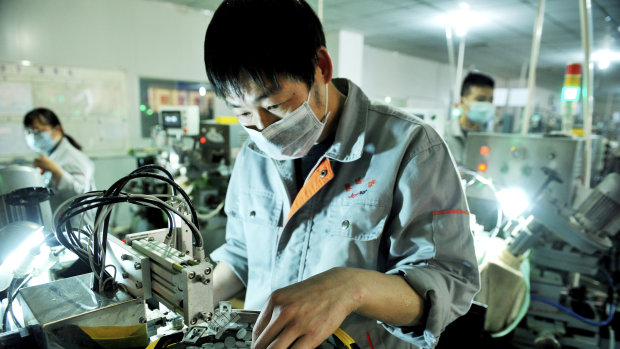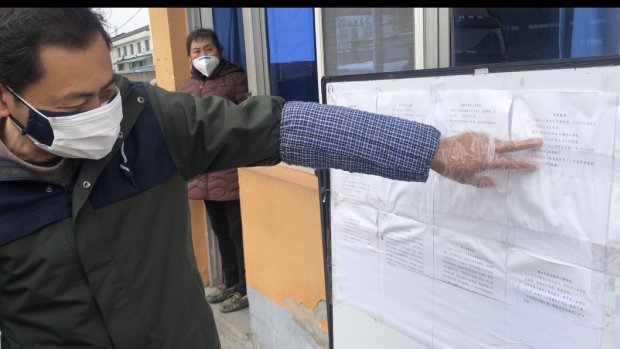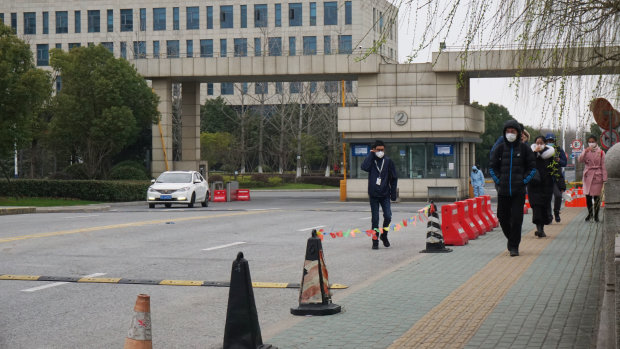This is what China's recovery looks like
Factories are still grappling with tough new health rules and the fact that many of their workers are either still unable to travel or in quarantine.
Updated
The eight-lane motorways are empty. the shopping outlets abandoned, and our taxi glides through rows of unmanned toll booths because their operators have been told to stay at home until the coronavirus outbreak has been fully contained.
Workers make optical lenses in a factory in Dexing city in central China's Jiangxi province. Factories that make the world's smartphones, toys and other goods are struggling to reopen across the country AP
The factories in Qingpu, home to many of Shanghai's sprawling industrial estates west of the city, are also silent. Except for the occasional stray dog, there is little sign of life in many of the industrial parks, whose rusty gates have been closed for more than five weeks. Road blocks surround entire villages, cut off from the rest of the world, and the cranes are idle on a huge construction site nearby.
Others are operating with a skeleton staff in the early stages of "cleaning up" and working through the onerous health procedures now demanded by the local government before operations can resume.
"We don't know when we will back at full operation because we need a licence and approvals," says Mr Lu, one of the managers at a small metal processing plant.
"We are also still trying to locate our staff. People from the government will come and check before giving us approval."
His factory has 22 staff, but many of the workers are still trying to get back to Shanghai after being marooned in parts of the country while visiting relatives for Chinese New Year, when the public emergency was first declared.
Mr Lu at his metal processing plant on the outskirts of Shanghai. "We don't know when we will back at full operation because we need a licence and approvals." Michael Smith
Others have made it back but have to do 14 days quarantine at home before they can come to work. "The rules are much stricter than during SARS," Mr Lu, 58, says, referring to China's last major health crisis in 2003.
It is a similar story down the road at the Flying Ball Valve Company, where half a dozen workers are clearing fallen trees from a courtyard at the front of the idle factory. A masked human resources manager named Ms Deo says more than half of their 50 workers are still in home quarantine or unable to return to Shanghai. She hopes the factory will be fully operational by the end of March.
The slow start for these, and other factories who spoke to The Australian Financial Review, is a reflection of what is going on throughout the country as the economy struggles to return to life. It is also confirmation that while some factories have reopened they are weeks, if not months away, from full production.
More than a third of China's 300 million migrant workers are yet to return to work, and those factories which can find staff must comply with strict rules to protect their workers from the virus which has now claimed 2744 lives in mainland China.
China's leaders are trying to kick-start the economy and avert an unemployment crisis while upholding the world's toughest quarantine rules and tight travel restrictions. President Xi Jinping told a meeting of 170,000 Communist Party cadres this week that the country needed to get back to work and China would not waver from its long-term economic goals.
That looks like a tough call given many of the country's smaller factories are nowhere near ready to resume full production. While many accept the need for strict measures to control the outbreak, some factory bosses are angry at what they say is preferential treatment being given to large state-owned enterprises.
One such case is the SAIC Motor Corporation, a large state-owned carmaker. It was a different scene this week as hundreds of staff, all wearing masks, poured out of the front gates of a SAIC assembly line at knock-off time. Dozens of buses ferrying staff home were also leaving, but many of them are empty, with at least two rows of seats separating each worker on board.
Not all in shutdown. Workers leave for the day at a SAIC Motor Corporation facility on the outskirts of Shanghai. Michael Smith
"About half the staff are back. We work in shifts. I am working from 8 am to 3:30 pm at the moment, but if I want to I don't have to start until 10 am," says Neon Wang, a 25-year-old test engineer, as he leaves for the day.
Wang says he has to complete a health report each day and tell his superiors if he has had any contact with friends or relatives travelling back to Shanghai from another part of China.
Workers say health regulations inside the plant are incredibly strict. Instead of eating together in a staff cafeteria as usual, they have to order their lunch online and collect a food box to be eaten alone at their work station.
Ms Deng, who works at local recruitment agency Jiepin Talent, says she is not worried about the economic damage from the cornonavirus outbreak hurting her business.
"There will be strong demand after the epidemic is finished. A lot of these factories have lots of overseas orders. They will need workers to meet this demand," says Ms Deng, who recruits for the textile, logistics and food processing factories in the area.
If one of Shanghai's main industrial estates is any guide, the propaganda coming out of Beijing that the world's factory is back up and running appears dubious.
The China Youth Daily newspaper said this week that more than 70 per cent of companies and factories in Shanghai had resumed operation. Governments in other industrial hubs such as the northern province of Hebei and Anhui in the east boast that 86 to 92 per cent of enterprises "above a designated size" have resumed operation.
Australia, fearful of the economic impact from China's coronavirus outbreak, is watching the country's efforts to restart the world's second-largest economy closely. Economists are tipping a 3 percentage point hit to first-quarter GDP growth. Beijing needs growth of 5.5 per cent in 2020 to hits its much-lauded target to double GDP over a decade.
It could still achieve that by revising down previous GDP figures.
As we drive back towards the city centre, a neon sign lights up on the side of the highway. "Let's join hands to fight the epidemic," it implores.




No comments:
Post a Comment